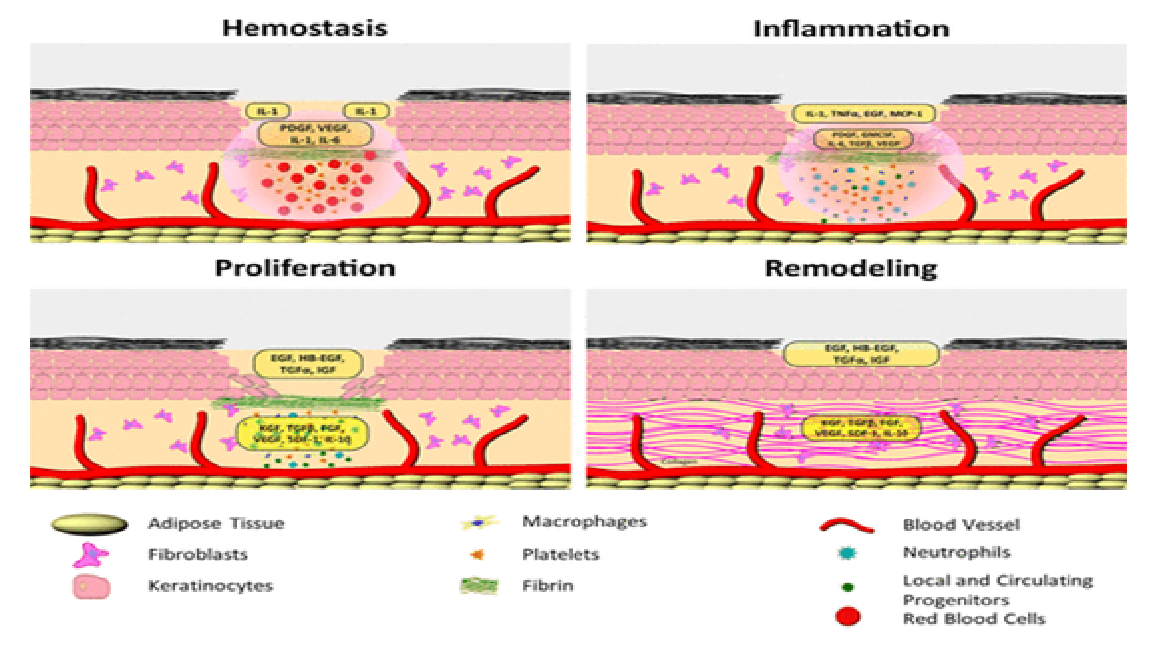Therapeutic Advances in Wound Healing
Main Article Content
Abstract
A wound is an injury to the biological form and function of an organ, such as the skin, produced by a simple or major rupture in the structure of the organ. Because a slow and ineffective repair might result in significant harm, full lesion healing necessitates rapid recovery of balanced physiological circumstances. The characteristics of the wound-healing mechanism can be used to classify wounds. A surface wound is a type of skin lesion that only affects the skin's epidermis. When the subcutaneous fat or underlying structures, such as blood arteries, sebaceous glands, and hair follicles, are compromised, full-thickness wounds develop. "Complex injuries" are wounds that are difficult to heal and cause substantial loss of skin, hair, and tissue. (Veins feeding the leg). The human body's intricate physiological process of wound healing involves coordinated sequential activation of many different cell types and signalling pathways. Chronic wounds and burns distinctly lower patients' quality of life because they are linked to an increase in physical discomfort and socioeconomic issues. As a result, improving the long-term viability of national health systems requires not just great interest but also the development of innovative and more affordable technologies and medicines.
Article Details
References
Oliveira, A., Simões, S., Ascenso, A., & Reis, C. P. (2022). Therapeutic advances in wound healing. The Journal of dermatological treatment, 33(1), 2–22. https://doi.org/10.1080/09546634.2020.1730296
https://onlinelibrary.wiley.com/doi/abs/10.1111/j.1365-3164.1997.tb00268.x
KUMAR, SENTHIL; WONG, PENG FOO; and LEAPER, DAVID JOHN (2004) "What is New in Wound Healing?," Turkish Journal of Medical Sciences: Vol. 34: No. 3, Article 1. Available at: https://journals.tubitak.gov.tr/medical/vol34/iss3/1
Boateng J, Catanzano O. Advanced Therapeutic Dressings for Effective Wound Healing—A Review. J Pharm Sci. 2015 Nov 1;104(11):3653–80.
https://www.sciencedirect.com/science/article/abs/pii/S0378517313010831
Fonder MA, Lazarus GS, Cowan DA, Aronson-Cook B, Kohli AR, Mamelak AJ. Treating the chronic wound: A practical approach to the care of nonhealing wounds and wound care dressings. J Am Acad Dermatol. 2008 Feb;58(2):185–206.
Sahana, T.G., Rekha, P.D. Biopolymers: Applications in wound healing and skin tissue engineering. Mol Biol Rep 45, 2857–2867 (2018). https://doi.org/10.1007/s11033-018-4296-3
Aziz Z, Cullum N, Flemming K. Electromagnetic therapy for treating venous leg ulcers. Cochrane Database Syst Rev. 2013 Feb 28;(2):CD002933.
Mir, M., Ali, M.N., Barakullah, A. et al. Synthetic polymeric biomaterials for wound healing: a review. Prog Biomater 7, 1–21 (2018). https://doi.org/10.1007/s40204-018-0083-4
Dhivya S, Padma VV, Santhini E (2015) Wound dressings—a review. Biomedicine 5(4):22
Zahedi P, Rezaeoam O, Ranaei-Siadat S, Jafari S, Supaphol P (2010) A review on wound dressings with an emphasis on electrospun nanofibrous polymeric bandages. Polym Adv Technol 21:77–95
Helfman T, Ovington L, Falanga V (1994) Occlusive dressings and wound healing. Clin Dermatol 12(1):121–127
Jeffcoate WJ, Price P, Harding KG (2004) Wound healing and treatments for people with diabetic foot ulcers. Diabetes Metab Res Rev 20(S1):S78–S89
Hutchinson J, Lawrence J (1991) Wound infection under occlusive dressings. J Hosp Infect 17(2):83–94
Najabat Ali M, Ansari U, Sami J, Qayyum F, Mir M (2016) To develop a biocompatible and biodegradable polymer-metal composite with good; mechanical and drug release properties. J Mater Sci Eng 5:274. https://doi.org/10.4172/2169-0022.1000274
Boonkaew B, Kempf M, Kimble R, Supaphol P, Cuttle L (2013) Antimicrobial efficacy of a novel silver hydrogel dressing compared to two common silver burn wound dressings: Acticoat™ and polymem Silver. Burns 40(1):89-96. https://doi.org/10.1016/j.burns.2013.05.011
Thomas Hess, Cathy BSN, RN, CWOCN. Checklist for Factors Affecting Wound Healing. Advances in Skin & Wound Care: April 2011 - Volume 24 - Issue 4 - p 192 doi: 10.1097/01.ASW.0000396300.04173.ec
Bishop A (2008) Role of oxygen in wound healing. J Wound Care 17(9):399–402 (Review)
Guo S, Dipietro LA (2010) Factors affecting wound healing. J Dent Res 89(3):219–229. https://doi.org/10.1177/0022034509359125
Godbout JP, Glaser R (2006) Stress-induced immune dysregulation: implications for wound healing, infectious disease and cancer. J Neuroimmune Pharmacol 1(4):421–427 (Review)
Radek KA, Matthies AM, Burns AL, Heinrich SA, Kovacs EJ, Dipietro LA (2005) Acute ethanol exposure impairs angiogenesis and the proliferative phase of wound healing. Am J Physiol Heart Circ Physiol 289(3):H1084–H1090
Ahn C, Mulligan P, Salcido RS (2008) Smoking-the bane of wound healing: biomedical interventions and social influences. Adv Skin Wound Care 21(5):227–236. https://doi.org/10.1097/01.asw.0000305440.62402.43 (quiz 237–8, Review)
https://www.liebertpub.com/doi/abs/10.1089/wound.2013.0506 https://doi.org/10.1089/wound.2013.0506
Martin P. Wound healing--aiming for perfect skin regeneration. Science. 1997 Apr 4;276(5309):75–81
Gurtner GC, Callaghan MJ, Longaker MT. Progress and potential for regenerative medicine. Annu Rev Med. 2007;58:299–312.
Hassan WU, Greiser U, Wang W Role of adipose-derived stem cells in wound healing. Wound Repair Regen. 2014;22(3):313–25.
Hunter S, Langemo DK, Anderson J, Hanson D, Thompson P. Hyperbaric oxygen therapy for chronic wounds. Adv Skin Wound Care. 2010 Mar;23(3):116–9.
Enoch S, Leaper DJ. Basic science of wound healing. Surg - Oxf Int Ed. 2008 Feb 1;26(2):31–7.
https://onlinelibrary.wiley.com/doi/full/10.1111/iwj.12170 https://doi.org/10.1111/iwj.12170
Orgill, Dennis P. M.D., Ph.D.; Bayer, Lauren R. P.A.-C.. Update on Negative-Pressure Wound Therapy. Plastic and Reconstructive Surgery: January 2011 - Volume 127 - Issue - p 105S-115Sdoi: 10.1097/PRS.0b013e318200a427
https://www.sciencedirect.com/science/article/abs/pii/S0094129807001058
DuBose JW, Cutshall C, Metters AT. Controlled release of tethered molecules via engineered hydrogel degradation: model development and validation. J Biomed Mater Res A. 2005 Jul 1;74(1):104–16.
ACS Cent. Sci. 2017, 3, 3, 163–175 Publication Date:February 27, 2017 https://pubs.acs.org/doi/full/10.1021/acscentsci.6b00371

